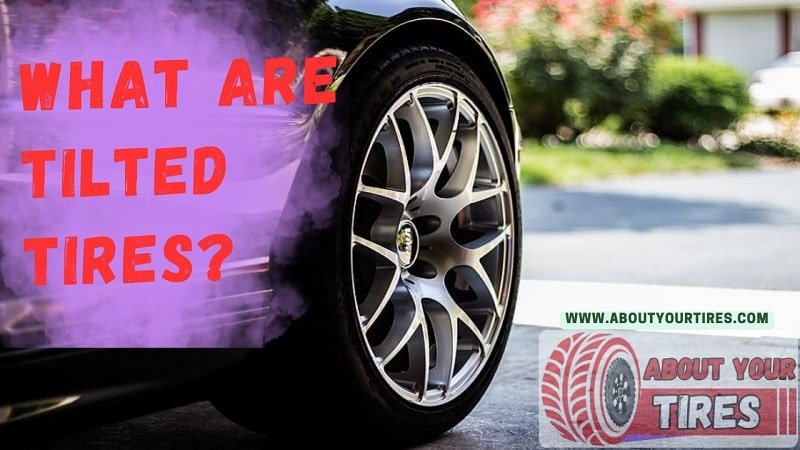Tires play a pivotal role in your vehicle’s performance and safety. They are the point of contact between your car and the road, influencing handling, traction, and overall driving experience. One critical aspect that can significantly affect how your tires interact with the road is the camber angle. In this comprehensive guide, we will delve into the world of tilted tires, exploring what are tilted tires called, their various types, their effects on your vehicle’s performance, and the often-debated question of whether they are good or bad. Let’s embark on this journey of discovery.
The Basics of Camber Angle
The camber angle, a fundamental concept in the world of automotive engineering, refers to the tilt or angle of your vehicle’s tire concerning the vertical axis. It determines how the tire makes contact with the road surface and significantly impacts tire wear and vehicle handling.
Camber can be categorized into three main types:
Positive Camber: Stability and Straight-Line Driving
Positive camber involves tilting the top of the tire away from the vehicle’s centerline. This configuration is characterized by a higher side of the tire when compared to the bottom. Positive camber contributes to improved stability during straight-line driving.
It is commonly used in applications where maintaining a straight trajectory is crucial. For instance, many off-road vehicles, agricultural equipment, and heavy-duty trucks use positive camber to prevent veering off course when navigating uneven terrains. Positive camber ensures that these vehicles remain steadfast on their intended paths, enhancing their overall safety and efficiency.
See also What Are Sanding Tires?
Negative Camber: The Cornering Enthusiast’s Choice
Conversely, negative camber involves tilting the top of the tire inward towards the vehicle’s centerline. This results in a lower side of the tire when compared to the top. Negative camber is often favoured by those who prioritize cornering performance.
One of the key benefits of negative camber is its ability to increase tire contact with the road surface during turns. This additional contact translates into improved handling and the capacity to tackle corners at higher speeds. Moreover, negative camber has the advantage of reducing tire wear by distributing the load more evenly across the tire.
Technical Insight: Negative camber can contribute to what is commonly known as “cornering force.” This force occurs when the lateral (sideways) component of the tire’s grip on the road is maximized during a turn. The resulting increased traction allows for more aggressive cornering, a feature highly sought after by racing enthusiasts.
Zero Camber: The Ideal Balance
Zero camber, as the name implies, refers to the tire’s vertical axis being perfectly perpendicular to the road surface. In this setup, the tire maintains uniform contact across its tread with the road.
Zero camber is often considered the ideal configuration for everyday driving. It strikes a balance between stability during straight-line driving and improved handling during turns. Most vehicles on the road, including passenger cars and SUVs, are equipped with tires that have zero camber.
Technical Insight: While zero camber is a balanced choice for everyday driving, it is not optimized for extreme performance scenarios. Consequently, performance-oriented vehicles may feature slightly negative camber to enhance cornering capabilities without sacrificing straight-line stability.
The Effects of Extreme Camber Angles
While moderate camber adjustments can enhance a vehicle’s performance, extreme camber angles can have negative consequences. Understanding these effects is crucial to making informed decisions about your vehicle’s setup:
Tire Wear
Extreme negative camber angles can accelerate tire wear. When a tire is tilted excessively, it can cause uneven tread wear, reducing the tire’s lifespan. Regular tire rotations become essential to mitigate this issue.
Straight-Line Performance
Vehicles with extreme camber setups can experience compromised straight-line performance. Excessive negative camber can lead to reduced traction when driving in a straight line, particularly during acceleration and braking.
Technical Insight: Excessive negative camber can lead to “acceleration squat” and “braking dive.” These are terms used to describe the phenomena where the vehicle’s rear end squats during acceleration and the front-end dives during braking, negatively impacting performance and safety.
Steering and Handling
Extreme camber angles can affect a vehicle’s steering and handling characteristics. Overly negative camber may lead to difficulties with steering and cornering at low speeds.
Suspension and Component Stress
The vehicle’s suspension components, including bushings and ball joints, can experience increased stress with extreme camber angles. Premature wear and potential component failure may result.
Traction in Wet Conditions
Tires with extreme camber configurations have limited traction on wet or slippery road surfaces. This can compromise the vehicle’s ability to steer and brake safely in adverse weather conditions.
Legal Considerations: Are Tilted Tires Allowed?
The legality of tilted tires varies depending on your location and the degree of tilt. In general, moderate camber adjustments are permissible and are not likely to raise legal concerns. However, extreme camber configurations, often associated with the “hellaflush” stance, have faced scrutiny in some regions.
Technical Insight: Extreme camber configurations can raise safety concerns, as they may affect a vehicle’s stability and handling. Regulations regarding vehicle modifications and tire setups are in place to ensure road safety and prevent potentially dangerous practices.
The Controversy Surrounding Extreme Camber
Extreme camber configurations, characterized by significant negative camber and lowered suspension, have gained attention within the automotive community. This controversial stance, known as “hellaflush,” often involves pushing the boundaries of tire tilt and vehicle modification.
Hellaflush enthusiasts seek a unique and eye-catching aesthetic that sets their vehicles apart. However, this extreme stance has sparked debates about safety, functionality, and the potential risks associated with such configurations.
Conclusion: Striking the Right Balance
In the world of tilted tires, the camber angle is a critical factor that significantly influences your vehicle’s performance and safety. Whether you prioritize stability during straight-line driving or enhanced cornering capabilities, understanding the effects of camber can guide your choices.
Achieving the ideal balance between positive and negative camber can offer the best of both worlds. While moderate camber adjustments can enhance your vehicle’s performance, it’s crucial to avoid extreme camber configurations to prevent adverse effects on tire wear, straight-line performance, handling, and safety.
FAQ
Q1: Are camber adjustments the same for all types of vehicles?
A1: Camber adjustments should be tailored to the vehicle’s intended use. Off-road and heavy-duty vehicles benefit from positive camber, while negative camber is favoured for performance-oriented and racing vehicles.
Q2: What is the recommended camber angle for everyday driving?
A2: For most passenger cars and SUVs, a camber angle close to zero is recommended. This provides a balanced setup suitable for everyday driving conditions.
Q3: Can I adjust the camber angle on my vehicle?
A3: Camber adjustments are possible, but it’s essential to consult with a professional to ensure the modifications are done correctly and within legal limits.
Q4: Is extreme camber associated with “hellaflush” legal everywhere?
A4: The legality of extreme camber configurations, such as “hellaflush,” varies by location. It’s essential to check local regulations to determine whether such setups comply with safety and roadworthiness standards.
Q5: How often should I rotate my tires to mitigate uneven wear from camber adjustments?
A5: Regular tire rotations are essential for vehicles with camber adjustments to ensure even tread wear. A common recommendation is to rotate the tires every 6,000 to 8,000 miles or as specified in your vehicle’s manual.

